An official website of the United States government
 United States Department of Labor
United States Department of Labor
Install, service, or repair automatic door mechanisms and hydraulic doors. Includes garage door mechanics.
Employment estimate and mean wage estimates for Mechanical Door Repairers:
| Employment (1) | Employment RSE (3) |
Mean hourly wage |
Mean annual wage (2) |
Wage RSE (3) |
|---|---|---|---|---|
| 22,680 | 5.6 % | $ 21.80 | $ 45,350 | 1.2 % |
Percentile wage estimates for Mechanical Door Repairers:
| Percentile | 10% | 25% | 50% (Median) |
75% | 90% |
|---|---|---|---|---|---|
| Hourly Wage | $ 13.63 | $ 16.70 | $ 20.78 | $ 25.69 | $ 31.28 |
| Annual Wage (2) | $ 28,340 | $ 34,740 | $ 43,220 | $ 53,440 | $ 65,060 |
Industries with the highest published employment and wages for Mechanical Door Repairers are provided. For a list of all industries with employment in Mechanical Door Repairers, see the Create Customized Tables function.
Industries with the highest levels of employment in Mechanical Door Repairers:
| Industry | Employment (1) | Percent of industry employment | Hourly mean wage | Annual mean wage (2) |
|---|---|---|---|---|
| Building Finishing Contractors | 9,770 | 1.22 | $ 22.30 | $ 46,390 |
| Building Equipment Contractors | 5,600 | 0.26 | $ 21.90 | $ 45,560 |
| Building Material and Supplies Dealers | 4,460 | 0.39 | $ 20.36 | $ 42,350 |
| Fabricated Metal Product Manufacturing (3323 and 3324 only) | 1,120 | 0.24 | $ 22.61 | $ 47,040 |
| Merchant Wholesalers, Durable Goods (4232, 4233, 4235, 4236, 4237, and 4239 only) | 680 | 0.05 | $ 19.63 | $ 40,830 |
Industries with the highest concentration of employment in Mechanical Door Repairers:
| Industry | Employment (1) | Percent of industry employment | Hourly mean wage | Annual mean wage (2) |
|---|---|---|---|---|
| Building Finishing Contractors | 9,770 | 1.22 | $ 22.30 | $ 46,390 |
| Building Material and Supplies Dealers | 4,460 | 0.39 | $ 20.36 | $ 42,350 |
| Building Equipment Contractors | 5,600 | 0.26 | $ 21.90 | $ 45,560 |
| Fabricated Metal Product Manufacturing (3323 and 3324 only) | 1,120 | 0.24 | $ 22.61 | $ 47,040 |
| Commercial and Industrial Machinery and Equipment (except Automotive and Electronic) Repair and Maintenance | 150 | 0.07 | $ 26.40 | $ 54,900 |
Top paying industries for Mechanical Door Repairers:
| Industry | Employment (1) | Percent of industry employment | Hourly mean wage | Annual mean wage (2) |
|---|---|---|---|---|
| Commercial and Industrial Machinery and Equipment (except Automotive and Electronic) Repair and Maintenance | 150 | 0.07 | $ 26.40 | $ 54,900 |
| Fabricated Metal Product Manufacturing (3323 and 3324 only) | 1,120 | 0.24 | $ 22.61 | $ 47,040 |
| Machinery, Equipment, and Supplies Merchant Wholesalers | 340 | 0.05 | $ 22.42 | $ 46,630 |
| Building Finishing Contractors | 9,770 | 1.22 | $ 22.30 | $ 46,390 |
| Building Equipment Contractors | 5,600 | 0.26 | $ 21.90 | $ 45,560 |
States and areas with the highest published employment, location quotients, and wages for Mechanical Door Repairers are provided. For a list of all areas with employment in Mechanical Door Repairers, see the Create Customized Tables function.

States with the highest employment level in Mechanical Door Repairers:
| State | Employment (1) | Employment per thousand jobs | Location quotient (9) | Hourly mean wage | Annual mean wage (2) |
|---|---|---|---|---|---|
| Texas | 2,400 | 0.20 | 1.22 | $ 20.59 | $ 42,820 |
| California | 2,240 | 0.14 | 0.83 | $ 26.15 | $ 54,380 |
| Florida | 1,880 | 0.22 | 1.37 | $ 19.39 | $ 40,320 |
| Georgia | 1,360 | 0.32 | 1.94 | $ 22.67 | $ 47,150 |
| Ohio | 980 | 0.19 | 1.17 | $ 20.22 | $ 42,060 |
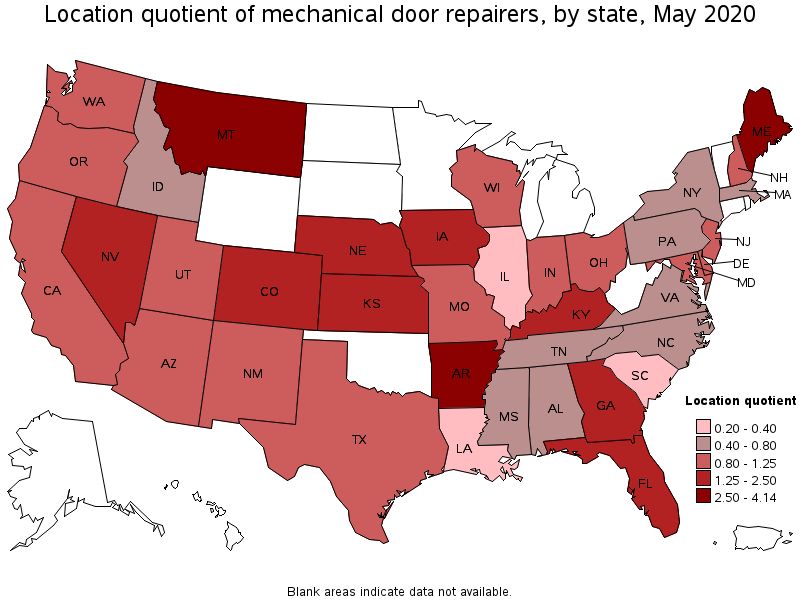
States with the highest concentration of jobs and location quotients in Mechanical Door Repairers:
| State | Employment (1) | Employment per thousand jobs | Location quotient (9) | Hourly mean wage | Annual mean wage (2) |
|---|---|---|---|---|---|
| Montana | 310 | 0.67 | 4.14 | $ 18.57 | $ 38,630 |
| Maine | 290 | 0.51 | 3.14 | $ 24.16 | $ 50,260 |
| Arkansas | 520 | 0.44 | 2.73 | $ 15.91 | $ 33,090 |
| Kansas | 510 | 0.38 | 2.32 | $ 22.29 | $ 46,360 |
| Iowa | 550 | 0.37 | 2.29 | $ 21.55 | $ 44,830 |
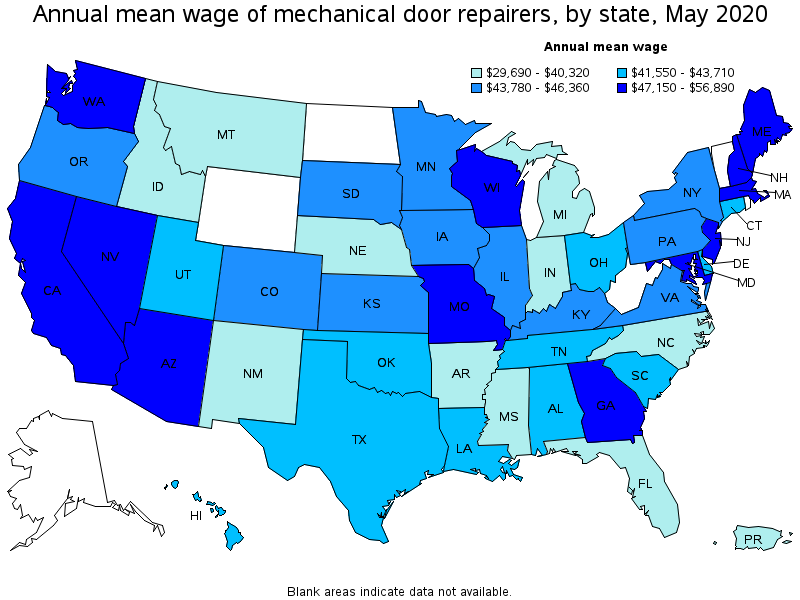
Top paying states for Mechanical Door Repairers:
| State | Employment (1) | Employment per thousand jobs | Location quotient (9) | Hourly mean wage | Annual mean wage (2) |
|---|---|---|---|---|---|
| Massachusetts | 380 | 0.11 | 0.70 | $ 27.35 | $ 56,890 |
| California | 2,240 | 0.14 | 0.83 | $ 26.15 | $ 54,380 |
| Missouri | 510 | 0.19 | 1.17 | $ 25.52 | $ 53,080 |
| Washington | 590 | 0.18 | 1.13 | $ 25.08 | $ 52,170 |
| Nevada | 280 | 0.23 | 1.38 | $ 24.97 | $ 51,940 |
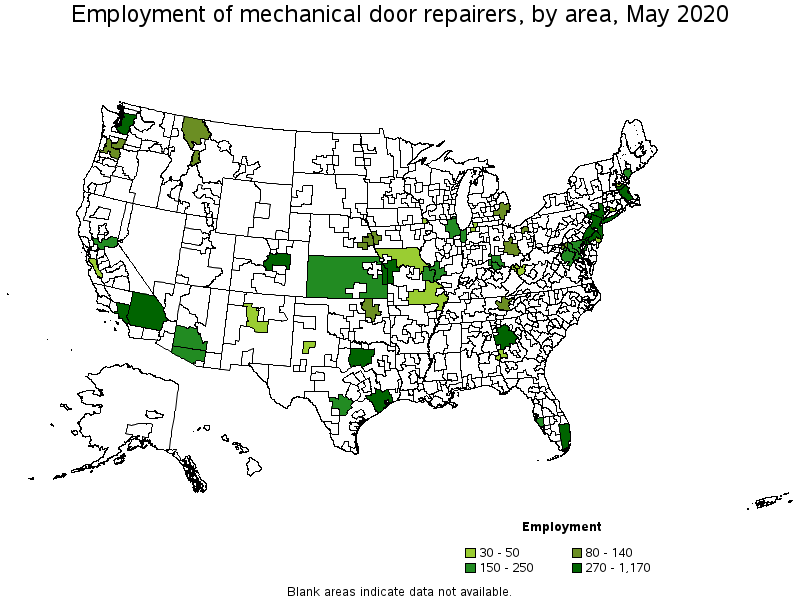
Metropolitan areas with the highest employment level in Mechanical Door Repairers:
| Metropolitan area | Employment (1) | Employment per thousand jobs | Location quotient (9) | Hourly mean wage | Annual mean wage (2) |
|---|---|---|---|---|---|
| Atlanta-Sandy Springs-Roswell, GA | 1,170 | 0.44 | 2.72 | $ 23.42 | $ 48,710 |
| Dallas-Fort Worth-Arlington, TX | 1,020 | 0.28 | 1.73 | $ 20.31 | $ 42,240 |
| Los Angeles-Long Beach-Anaheim, CA | 710 | 0.12 | 0.75 | $ 27.33 | $ 56,850 |
| New York-Newark-Jersey City, NY-NJ-PA | 610 | 0.07 | 0.42 | $ 23.22 | $ 48,300 |
| Seattle-Tacoma-Bellevue, WA | 490 | 0.25 | 1.54 | $ 26.27 | $ 54,640 |
| Kansas City, MO-KS | 440 | 0.43 | 2.64 | $ 28.05 | $ 58,350 |
| Houston-The Woodlands-Sugar Land, TX | 430 | 0.15 | 0.89 | $ 24.77 | $ 51,520 |
| Denver-Aurora-Lakewood, CO | 370 | 0.25 | 1.55 | $ 22.07 | $ 45,910 |
| Riverside-San Bernardino-Ontario, CA | 360 | 0.24 | 1.49 | $ 27.19 | $ 56,550 |
| Philadelphia-Camden-Wilmington, PA-NJ-DE-MD | 310 | 0.11 | 0.70 | $ 23.76 | $ 49,410 |
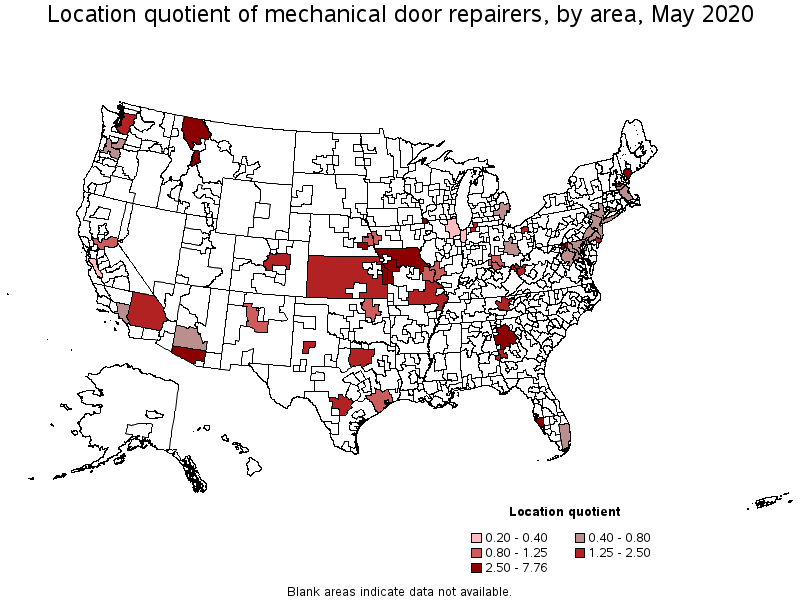
Metropolitan areas with the highest concentration of jobs and location quotients in Mechanical Door Repairers:
| Metropolitan area | Employment (1) | Employment per thousand jobs | Location quotient (9) | Hourly mean wage | Annual mean wage (2) |
|---|---|---|---|---|---|
| Portland-South Portland, ME | 220 | 1.09 | 6.70 | $ 25.51 | $ 53,060 |
| Hagerstown-Martinsburg, MD-WV | 100 | 1.06 | 6.52 | $ 23.08 | $ 48,000 |
| Dubuque, IA | 40 | 0.71 | 4.36 | $ 20.25 | $ 42,120 |
| Tucson, AZ | 250 | 0.67 | 4.14 | $ 22.36 | $ 46,500 |
| North Port-Sarasota-Bradenton, FL | 190 | 0.64 | 3.95 | $ 19.15 | $ 39,830 |
| Lincoln, NE | 100 | 0.60 | 3.69 | $ 18.46 | $ 38,390 |
| Atlanta-Sandy Springs-Roswell, GA | 1,170 | 0.44 | 2.72 | $ 23.42 | $ 48,710 |
| Kansas City, MO-KS | 440 | 0.43 | 2.64 | $ 28.05 | $ 58,350 |
| Huntington-Ashland, WV-KY-OH | 50 | 0.39 | 2.42 | $ 18.53 | $ 38,550 |
| Manchester, NH | 40 | 0.37 | 2.27 | $ 24.18 | $ 50,280 |
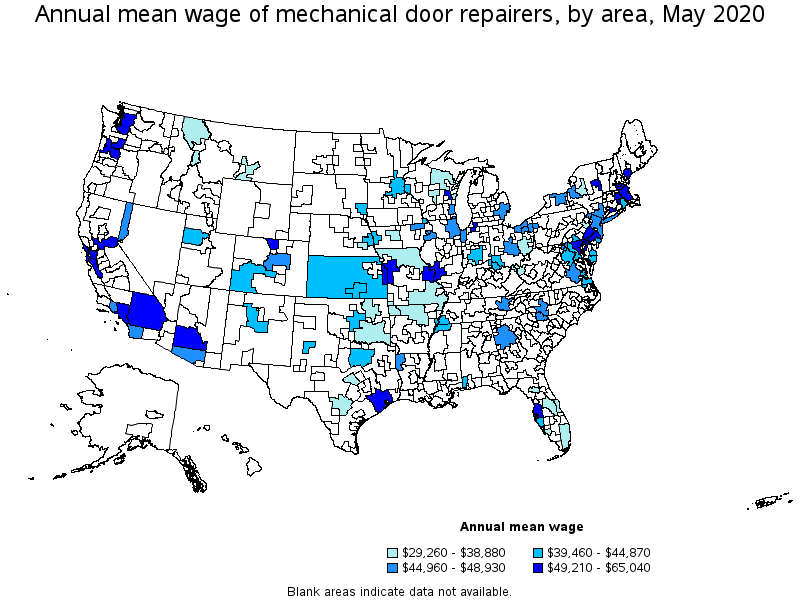
Top paying metropolitan areas for Mechanical Door Repairers:
| Metropolitan area | Employment (1) | Employment per thousand jobs | Location quotient (9) | Hourly mean wage | Annual mean wage (2) |
|---|---|---|---|---|---|
| San Jose-Sunnyvale-Santa Clara, CA | 40 | 0.04 | 0.23 | $ 31.27 | $ 65,040 |
| Boston-Cambridge-Nashua, MA-NH | 270 | 0.10 | 0.63 | $ 29.68 | $ 61,730 |
| Appleton, WI | (8) | (8) | (8) | $ 29.43 | $ 61,210 |
| Tampa-St. Petersburg-Clearwater, FL | (8) | (8) | (8) | $ 28.21 | $ 58,690 |
| Sacramento--Roseville--Arden-Arcade, CA | 180 | 0.19 | 1.16 | $ 28.15 | $ 58,550 |
| Kansas City, MO-KS | 440 | 0.43 | 2.64 | $ 28.05 | $ 58,350 |
| Los Angeles-Long Beach-Anaheim, CA | 710 | 0.12 | 0.75 | $ 27.33 | $ 56,850 |
| Riverside-San Bernardino-Ontario, CA | 360 | 0.24 | 1.49 | $ 27.19 | $ 56,550 |
| Phoenix-Mesa-Scottsdale, AZ | 150 | 0.07 | 0.44 | $ 27.09 | $ 56,350 |
| Baltimore-Columbia-Towson, MD | 160 | 0.12 | 0.74 | $ 26.93 | $ 56,010 |
Nonmetropolitan areas with the highest employment in Mechanical Door Repairers:
| Nonmetropolitan area | Employment (1) | Employment per thousand jobs | Location quotient (9) | Hourly mean wage | Annual mean wage (2) |
|---|---|---|---|---|---|
| Kansas nonmetropolitan area | 150 | 0.38 | 2.35 | $ 19.50 | $ 40,560 |
| West Montana nonmetropolitan area | 90 | 1.26 | 7.76 | $ 18.23 | $ 37,920 |
| North Missouri nonmetropolitan area | 50 | 0.44 | 2.69 | $ 17.87 | $ 37,170 |
| Southeast Missouri nonmetropolitan area | 40 | 0.25 | 1.54 | $ 17.40 | $ 36,200 |
Nonmetropolitan areas with the highest concentration of jobs and location quotients in Mechanical Door Repairers:
| Nonmetropolitan area | Employment (1) | Employment per thousand jobs | Location quotient (9) | Hourly mean wage | Annual mean wage (2) |
|---|---|---|---|---|---|
| West Montana nonmetropolitan area | 90 | 1.26 | 7.76 | $ 18.23 | $ 37,920 |
| North Missouri nonmetropolitan area | 50 | 0.44 | 2.69 | $ 17.87 | $ 37,170 |
| Kansas nonmetropolitan area | 150 | 0.38 | 2.35 | $ 19.50 | $ 40,560 |
| Southeast Missouri nonmetropolitan area | 40 | 0.25 | 1.54 | $ 17.40 | $ 36,200 |
Top paying nonmetropolitan areas for Mechanical Door Repairers:
| Nonmetropolitan area | Employment (1) | Employment per thousand jobs | Location quotient (9) | Hourly mean wage | Annual mean wage (2) |
|---|---|---|---|---|---|
| Southwest Colorado nonmetropolitan area | (8) | (8) | (8) | $ 20.60 | $ 42,850 |
| Kansas nonmetropolitan area | 150 | 0.38 | 2.35 | $ 19.50 | $ 40,560 |
| West Montana nonmetropolitan area | 90 | 1.26 | 7.76 | $ 18.23 | $ 37,920 |
| Northeastern Wisconsin nonmetropolitan area | (8) | (8) | (8) | $ 17.97 | $ 37,370 |
| North Missouri nonmetropolitan area | 50 | 0.44 | 2.69 | $ 17.87 | $ 37,170 |
These estimates are calculated with data collected from employers in all industry sectors, all metropolitan and nonmetropolitan areas, and all states and the District of Columbia. The top employment and wage figures are provided above. The complete list is available in the downloadable XLS files.
The percentile wage estimate is the value of a wage below which a certain percent of workers fall. The median wage is the 50th percentile wage estimate—50 percent of workers earn less than the median and 50 percent of workers earn more than the median. More about percentile wages.
(1) Estimates for detailed occupations do not sum to the totals because the totals include occupations not shown separately. Estimates do not include self-employed workers.
(2) Annual wages have been calculated by multiplying the hourly mean wage by a "year-round, full-time" hours figure of 2,080 hours; for those occupations where there is not an hourly wage published, the annual wage has been directly calculated from the reported survey data.
(3) The relative standard error (RSE) is a measure of the reliability of a survey statistic. The smaller the relative standard error, the more precise the estimate.
(8) Estimate not released.
(9) The location quotient is the ratio of the area concentration of occupational employment to the national average concentration. A location quotient greater than one indicates the occupation has a higher share of employment than average, and a location quotient less than one indicates the occupation is less prevalent in the area than average.
Other OEWS estimates and related information:
May 2020 National Occupational Employment and Wage Estimates
May 2020 State Occupational Employment and Wage Estimates
May 2020 Metropolitan and Nonmetropolitan Area Occupational Employment and Wage Estimates
May 2020 National Industry-Specific Occupational Employment and Wage Estimates
Last Modified Date: March 31, 2021